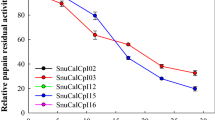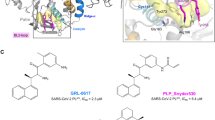Abstract
Leech carboxypeptidase inhibitor (LCI) is a novel protein inhibitor present in the medicinal leech Hirudo medicinalis. The structures of LCI free and bound to carboxypeptidase A2 (CPA2)have been determined by NMR and X-ray crystallography, respectively. The LCI structure defines a new protein motif that comprises a five-stranded antiparallel β-sheet and one short α-helix. This structure is preserved in the complex with human CPA2 in the X-ray structure, where the contact regions between the inhibitor and the protease are defined. The C-terminal tail of LCI becomes rigid upon binding the protease as shown in the NMR relaxation studies, and it interacts with the carboxypeptidase in a substrate-like manner. The homology between the C-terminal tails of LCI and the potato carboxypeptidase inhibitor represents a striking example of convergent evolution dictated by the target protease. These new structures are of biotechnological interest since they could elucidate the control mechanism of metallo-carboxypeptidases and could be used as lead compounds for the search of fibrinolytic drugs.
This is a preview of subscription content, access via your institution
Access options
Subscribe to this journal
Receive 12 print issues and online access
$189.00 per year
only $15.75 per issue
Buy this article
- Purchase on Springer Link
- Instant access to full article PDF
Prices may be subject to local taxes which are calculated during checkout






Similar content being viewed by others
References
Reverter, D., et al. A carboxypeptidase inhibitor from the medical leech Hirudo medicinalis. Isolation, sequence analysis, cDNA cloning, recombinant expression and characterization. J. Biol. Chem. 273, 32927–32933 (1998).
Eaton, D.L., Malloy, B.E., Tsai, S.P., Henzel, W. & Drayna, D. Isolation, molecular cloning, and partial characterization of a novel carboxypeptidase B from human plasma. J. Biol. Chem. 266, 21833–21838 (1991).
Reynolds, D.S., et al. Cloning of cDNAs that encode human mast cell carboxypeptidase A, and comparison of the protein with mouse mast cell carboxypeptidase A and rat pancreatic carboxypeptidases. Proc. Natl Acad. Sci. USA 86, 9480–9484 (1989).
Clore, M., Gronenborn, A.M., Nilges, M. & Ryan, C.A. Three-dimensional structure of potato carboxypeptidase inhibitor in solution. A study using nuclear magnetic resonance, distance geometry, and restrained molecular dynamics. Biochemistry 26, 8012–8023 (1987).
Rees, D.C. & Lipscomb, W.N. Refined crystal structure of the potato inhibitor complex of carboxypeptidase A at 2.5 Å resolution. J. Mol. Biol. 160, 475–498 (1982).
Aviles, FX., Vendrell, J., Guasch, A., Coll, M Huber R. Advances in metallo-procarboxypeptidases. Emerging details on the inhibition mechanism and on the activation process. Eur J Biochem. 211, 381–389 (1993).
Molina, M.A., Marino, C., Oliva, B., Aviles, F.X. & Querol, E. C-tail valine is a key residue for stabilization of complex between potato inhibitor and carboxypeptidase A. J Biol. Chem. 269, 21467–21472 (1994).
Tuszynski, G.P., Gasic, T.B. & Gasic, G.J. Isolation and characterization of antistasin. An inhibitor of metastasis and coagulation. J. Biol. Chem. 262, 9718–9723 (1987).
Rydel, T.J., et al. The structure of a complex of recombinant hirudin and human alpha-thrombin. Science 249, 277–280 (1990).
Bode, W., Papamokos, E., Musil, D., Seemüller, U. & Fritz, H. Refined 1.2 Å crystal structure of the complex formed between subtilisin Carlsberg and the inhibitor eglin c. Molecular structure of eglin and its detailed interaction with subtilisin. EMBO J. 5, 813–8 (1986).
Bolognesi, M., et al. X-ray crystal structure of the bovine alpha-chymotrypsin/eglin c complex at 2.6 Å resolution. J Mol. Recognit. 3, 163–168 (1990).
Mittl, P.R., et al. A new structural class of serine protease inhibitors revealed by the structure of the hirustasin-kallikrein complex. Structure 5, 253–264 (1997).
Mühlhahn, P., et al. Structure of leech derived tryptase inhibitor (LDTI-C) in solution. FEBS Lett. 355, 290–296 (1994).
Stubbs, M.T., et al. The three-dimensional structure of recombinant leech-derived tryptase inhibitor in complex with trypsin. Implications for the structure of human mast cell tryptase and its inhibition. J. Biol. Chem. 272, 19931–19937 (1997).
Bajzar, L., Manuel, R. & Nesheim, M.E. Purification and characterization of TAFI, a thrombin-activable fibrinolysis inhibitor. J. Biol. Chem. 270, 14477–14484 (1995).
Sakharov D.V., Plow, E.F. & Rijken, C. On the mechanism of the antifibrinolytic activity of plasma carboxypeptidase B. J. Biol. Chem. 272, 14477–14482 (1997).
Huntley, J.F., et al. Distribution of intestinal mast cell proteinase in blood and tissues of normal and Trichinella-infected mice. Parasite Immunol. 12, 85–95 (1990).
Arizono, N., et al. Lung granulomatous response induced by infection with the intestinal nematode Nippostrongylus brasiliensis is suppressed in mast cell-deficient Ws/Ws rats. Clin. Exp. Immunol. 106, 55–61 (1996).
García-Sáez, I., Reverter, D., Vendrell, J., Avilés, F.X. & Coll, M. The three-dimensional structure of human procarboxypeptidase A2. Deciphering the basis of its inhibition, activation and intrinsic activity of the zymogen EMBO J., 23, 6906–6913 (1997).
Wüthrich, K. NMR of Proteins & Nucleic Acids (Wiley, New York; 1986).
Farrow N.A. et al. Backbone dynamics of a free and a phosphopeptide-complexed Src homology 2. Study by 15N NMR relaxation. Biochemistry 33, 5984–6003 (1994).
Coll, M., Guasch, A., Aviles, FX. & Huber, R. Three-dimensional structure of porcine procarboxypeptidase B: a structural basis of its inactivity. EMBO J. 10, 1–9 (1991).
Teplyakov, AV., et al. Crystal structure of carboxypeptidase T from Thermoactinomyces vulgaris. Eur. J. Biochem. 208, 281–288 (1992).
Gomis-Rüth, FX., Gomez, M., Bode, W., Huber, R. & Aviles, F.X. The three-dimensional structure of the native ternary complex of bovine pancreatic procarboxypeptidase A with proproteinase E and chymotrypsinogen C. EMBO J. 14, 4387–4394 (1995).
Christianson, D.W. & Lipscomp, W.N. Carboxypeptidase A. Accts Chem. Res. 22, 62–69 (1989).
Nesheim, M., et al. Thrombin, thrombomodulin and TAFI in the molecular link between coagulation and fibrinolysis. Thromb. Haemost. 78, 386–391 (1997).
Reverter, D., Ventura, S., Villegas, V., Vendrell, J. & Avilés, F.X. Overexpression of human procarboxypeptidase A2 in Pichia pastoris and detailed characterization of its activation pathway. J. Biol. Chem. 273, 3535–3541 (1998).
Smith, G.K., et al. Toward antibody-directed enzyme prodrug therapy with the T268G mutant of human carboxypeptidase A1 and novel in vivo stable prodrugs of methotrexate. J. Biol. Chem. 272, 15804–15816 (1997).
Ernst, R.R., Bodenhausen, G. & Wokaun, A. Principles of NMR in One and Two Dimensions (Clarendon Press, Oxford; 1987).
Rance, M. Improved techniques for homonuclear rotating-frame and isotropic mixing experiments. J. Magn. Reson. 74, 557–564 (1987).
Jeener, J., Meier, B.H., Bachman, P. & Ernst, R.R. Investigation of exchange processes by two-dimensional NMR spectroscopy. J. Chem. Phys. 71, 4546–4553 (1979).
Bax, A. Davis, D.G. MLEV-17-Based two-dimensional homonuclear magnetization transfer spectroscopy. J. Magn. Reson. 65, 355–360 (1985).
Dhalluin, C., Wieruszeki, J.M. & Lippens, G. An improved homonuclear TOCSY experiment with minimal water saturation. J. Magn. Reson. III 168–170 (1996).
Holak, T.A., Gondol, D., Otlewski, J. & Wilusz, T. Determination of the complete 3-dimensional structure of the trypsin-inhibitor from squash seeds in aqueous-solution by nuclear magnetic-resonance and a combination of distance geometry and dynamical simulated annealing. J. Mol. Biol. 210, 635–648 (1989).
Kim, Y. & Prestegard, J.H. Measurement of vicinal couplings from cross peaks in COSY spectra. J. Magn. Reson. 84, 9–13 (1989).
Hyberts, S.G., Mäki, W. & Wagner, G. Stereospecific assignments of side-chain protons and characterization of torsion angles in Eglin C. Eur. J. Biochem. 164, 625–635 (1987).
Brünger, A.T., XPLOR: a System for X-ray Crystallography and NMR (Yale University, New Haven, CT; 1993).
Jancarik, J. & Kim, S.H. Sparse matrix sample: a screening method for crystallization of proteins. J. Appl. Crystallogr. 24, 409–411 (1991).
Otwinowski, Z. & Minor, W. DENZO: A film processing for macromolecular crystallography. (Yale University, New Haven, Connecticut; 1993).
Navaza, J. AmoRe: an automated package for molecular replacement. Acta Crystallogr. A 50, 157–163 (1994).
Collaborative Computational Project, Number 4. CCP4 suite: programs for protein crystallography. Acta Crystallogr. D 50, 760–763 (1994).
Roussell, A & Cambilleau, C. TURBO-FRODO in Silicon Graphics Geometry (Silicon Graphics, Mountain View, California; 1991).
Nicholls, A., Sharp, K., & Honig, B. Protein folding and association: insights from the interfacial and thermodynamic properties of hydrocarbons. Proteins 11, 281–296 (1991).
Acknowledgements
D. Reverter is a recipient of a fellowship from the European Community Biotechnology Marie Curie program. Thanks to John Richardson for helpful discussions. This work was supported by the Deutsche Forschungsgemeinschaft, the Ministerio de Educación y Cultura (Spain), by the Centre de Referència en Biotecnologia (Generalitat de Catalunya) and by the E.C. Biotechnology Programme.
Author information
Authors and Affiliations
Corresponding authors
Rights and permissions
About this article
Cite this article
Reverter, D., Fernández-Catalán, C., Baumgartner, R. et al. Structure of a novel leech carboxypeptidase inhibitor determined free in solution and in complex with human carboxypeptidase A2. Nat Struct Mol Biol 7, 322–328 (2000). https://doi.org/10.1038/74092
Received:
Accepted:
Issue Date:
DOI: https://doi.org/10.1038/74092
This article is cited by
-
Localization of ligand binding site in proteins identified in silico
Journal of Molecular Modeling (2007)
-
The many faces of protease–protein inhibitor interaction
The EMBO Journal (2005)



